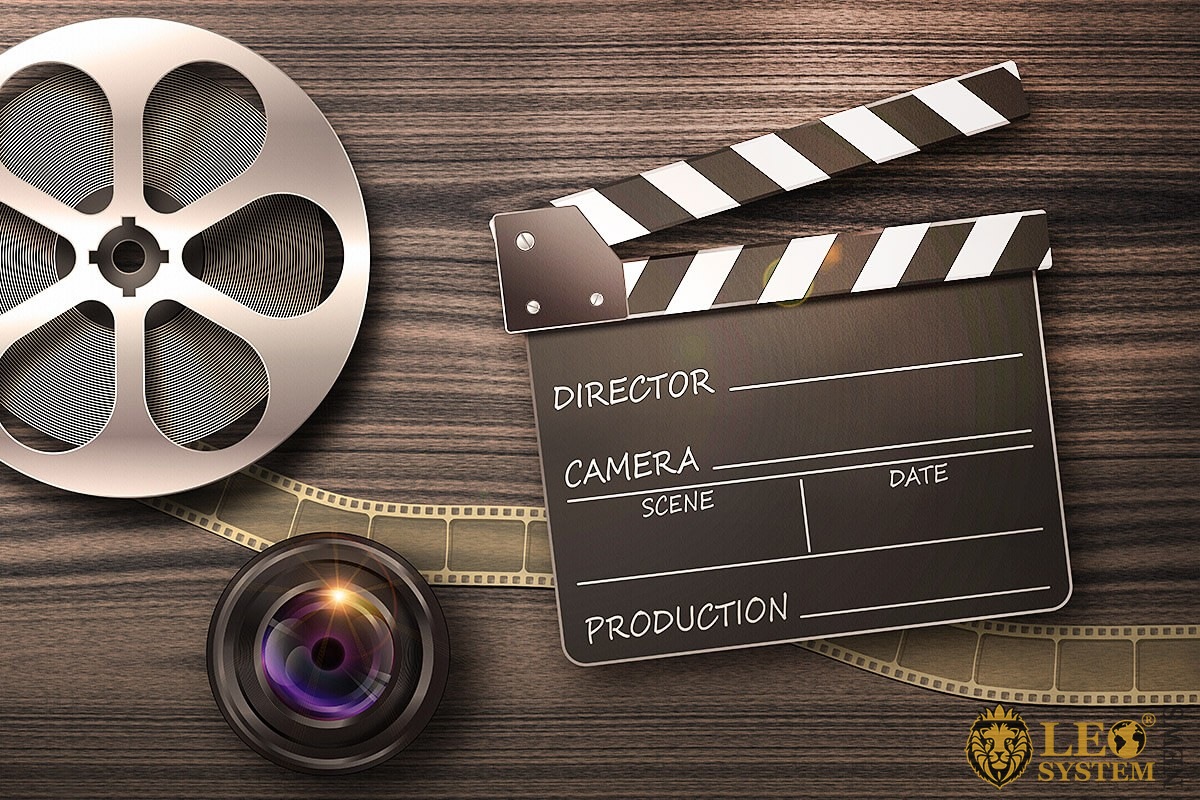Entertainment
The Evolution of Film Reels: A Look at Their History and Transition to Digital

Film reels were once the standard for capturing memories. From home movies to feature-length films, these cylindrical containers were a popular way to preserve moments in time.
While they’re not as widely used today, there are still people who own film reels with content that needs to be transferred into digital archives before it’s lost forever.
In this article, let’s take a look at the evolution of film reels, from their humble beginnings to their transition to digital formats. We’ll also explore how to transfer old film reels into digital formats to preserve them for the future.
What Are Film Reels?
Film reels are cylindrical containers that store motion picture films. They come in various sizes, the most common being 8mm and 16mm, with larger formats like 35mm used for theatrical releases.
Reels contain multiple layers of film strips that are spooled on top of each other around a central hub or hub spindle, with the film going onto a feed reel on one side and off onto a takeup reel on the other. The film is stored in this spooled format so that it can easily be transported from one location to another without becoming tangled or damaged.
The Early Days of Film Reels
Film reels were invented in the late 1800s and became widely used in the early 1900s. They were perfect for capturing home movies, or “amateur films” as they were called back then.
Hollywood filmmakers also adopted film reels, using 8mm and 16mm film formats to make their feature-length masterpieces. 35mm was the professional industry standard.
Film reels were the primary method of capturing memories up until the mid-1980s, and they would remain popular for decades due to their convenience, affordability, and easy-to-use nature.
Film reels also allowed for the transfer of memories from one generation to the next. Amateur filmmakers could transfer home movies onto film reels and then share them with family members. This allowed for greater preservation and transfer of information, as these films could be enjoyed for generations.
The Transition to Digital
As home video technology began to improve in the mid-1980s, with VHS and Betamax tapes becoming more affordable and accessible, film reels started to become less popular.
By the early 2000s, digital formats such as DVDs and Blu-Ray discs had taken over. Thanks to the advancements in digital technology, transferring old film reels into digital files has become much easier.
There are many transfer services available, such as Capture, that can transfer 8mm, 16mm, and 35mm film reels into various digital formats such as MP4 or MOV. Capture’s film-to-digital conversion services are safe, secure, and high-quality.
Their experts use the latest technology and techniques to help transfer memories that were once locked away on film reels, preserving them in digital archives for the future.
In Conclusion
The film reel is a historical format that has been around since the late 1800s. They’re still used today by filmmakers, photographers, and hobbyists who enjoy collecting old films, but with technology constantly evolving, it’s important to transfer old film reels into digital formats to preserve them for future generations.
Thankfully, transfer services like Capture make it easy to convert film reels into digital files so that these memories can be enjoyed for many more years.
So if you have old film reels with precious memories that you’d like to digitize, be sure to preserve your legacy today!
Entertainment
Unraveling Mysteries: The Enigma of the Cat in the Chrysalis Spoiler Alert

Christine Norris’s Cat in the Chrysalis Spoiler is a fantastical and science fictional book. Readers of all ages were captivated by its broad cast of characters, fascinating narrative, and rich world-building upon its 2020 publication.
Cat, the protagonist, is a little girl who has never fit in anywhere in her sleepy hometown. After she stumbles onto a secret magical library, her life takes a dramatic turn as she sets out on a quest to find herself and her place in the world.
The idea of chrysalises, which are like cocoons or protective barriers, that hold and maintain strong supernatural beings is one of the most intriguing parts of this book. In Cat’s quest to learn the truth about her family’s history and its connection to the supernatural, these chrysalises are vital.
Cat in the Chrysalis Spoiler: The Tale So Far
A number of significant changes occurred in your cat. This cute little animal that loves you no matter what starts acting strange all of a sudden. It has taken to rushing about the house, clawing furniture, and meowing at strange hours. After seeing the vet, it is entering puberty and beginning to mature into maturity.
As a cat matures into an adult, its body changes, and the surge of hormones can cause behavioural issues. During this period, cats go through a lot of emotional and physical changes, so you could notice them becoming restless, meowing a lot, or marking their territory.
The spaying or neutering of the cats should be done without delay. A happier and better life, with fewer behavioural issues, is what this promises. More playtime, more affection, and a perfectly secure house are always good ideas. Additionally, with the help and once this challenging time is over, Cat will become an adult who is more composed and mature.
Although cats endure a difficult chrysalis, they may blossom into wonderful companions with the right amount of love and attention. In time, this cute little caterpillar will transform into a lovely butterfly.
Cat in the Chrysalis Spoiler: Twists and Turns
Right here you can find all the key Cat in the Chrysalis spoilers. You won’t believe how many plot twists there are in this science fiction mystery series.
The talking cat!
Chrysalis, the cat in the novel, was smartened up through genetic engineering, as you will discover. Chrysalis reveals her ability to communicate with Jenny—the story’s heroine and the lone scientist telepathically living a space station—through her abilities. With this shocking revelation, the story’s latter sections begin.
Jenny’s love and how it went
Jenny finds herself smitten with Mark, the dashing new crew member. Regardless, Mark, the dashing crew has been subtly directing Jenny under the orders of the sinister organisation responsible for Chrysalis’s creation. Following Mark’s deceit, Jenny triumphed against him and his gang of dweebs in a stunning confrontation to save Chrysalis.
What was done to Chrysalis?
Jenny knows that Chrysalis isn’t safe since the firm is after her after she foiled Mark’s evil plans. In a heartbreaking climax, Jenny assists Chrysalis in planning her escape and sends her soaring into the lovely space to live her life freely. Because of Jenny’s psychic cat and their link, they both have bright futures ahead of them, yet they must part ways.
The amount of shocks and sadness in “Cat in the Chrysalis” is equal. Deep down, though, it’s a story of an incredible friendship that serves as a reminder of the strength in reciprocal connections. In addition, if you enjoy serious science-based fiction, this narrative will remain with you long after you finish reading it.
How does it end?
The sunny tone of “Cat in the Chrysalis” lingers till the very end. Jenny’s death for stopping the terrible Queen Xenia leaves you in wonder of what happens in this strange planet.
Appearance of the New Villain
There are signs in the conclusion that a new danger to the country is approaching. The evil wizard Morlock begins to gather power and plots his vengeance after being banished for a long period. In the next installment, Morlock may play a pivotal antagonistic role.
Unresettled storylines
Several loose ends in the plot will also be available for exploration in the sequel that is in the works.
Significant turns in the story’s plot
In “Cat in the Chrysalis,” the twists and turns that the author includes are what really pull the reader in. These moments, which can vary from shocking discoveries to unforeseen turns, captivate readers and make a lasting impression.
Discussion of the relevance of the ending
The divisive ending has become one of Cat in the Chrysalis’s most famous aspects. Even if it was perfect for some viewers, it may have left others feeling bewildered and uncomfortable. Here, we’ll analyse the ending from every angle and talk about its significance in relation to the film’s overarching ideas and themes.
Conclusion
Your mind has been racing since you read the last chapter of the new mystery series Cat in the Chrysalis. This season has been filled with several mysteries and cliffhangers. Who was the real executioner of Thomas? Cats seem to be involved in a disproportionate number of break-ins.
You’ve come to the right place, my friend. Everything that goes down behind the scenes and how the season concludes is known to us. You should get ready to have your head spun by the sudden twists and turns that are about to happen. Unexpectedly shocking will be the ultimate revelation of the truth. For fans of Callie and Jake, the wait will be worthwhile. So pour yourself a drink of wine, grab a comfy chair, and relax.
FAQs
Does “Cat in the Chrysalis” fit the needs of every reader?
Some of the mystery and suspense elements may be too juvenile for very young readers, even if the novel is suitable for teens and adults.
Why did the writer of “Cat in the Chrysalis” compose it?
An individual’s private life and a preoccupation with self-improvement served as inspiration for the author.
Are there any Easter eggs or hidden clues in the book that readers might not see when reading it for the first time?
Yes, keen readers may pick up on subtle clues that become more apparent upon further perusal.
Is there a “Cat in the Chrysalis” sequel in the works?
There may not be any official announcement on a sequel just yet, but the author has left room for further exploration of the story’s universe.
In what store can I get “Cat in the Chrysalis”?
You may find “Cat in the Chrysalis” in most bookstores and on the internet. You may access it here as well.
Entertainment
Slope Unblocked Games 76: Unveiling the Thrills of Online Gaming

One name that has been making headlines in the lightning-fast realm of internet gaming is “Slope Unblocked Games 76.” Let’s go into the fascinating world of this gaming phenomenon and investigate its origins, features, availability, and effects on people and society.
1. Introduction
Definition of Slope Unblocked Games 76
Slope Unblocked Games 76 is a compelling choice for players looking for exciting experiences, and online games in general have become a vital part of our digital ecosystem.
2. History
Evolution of Online Gaming
The evolution of online gaming has been marked by tremendous changes, from the introduction of simple visuals to the introduction of complex games. As evidence of its development, Slope Unblocked Games 76 provides gamers from all around the world with state-of-the-art content.
3. Features
Interactive Gameplay
Slope Unblocked Games 76’s appeal comes from its challenging, dynamic gameplay, which puts players’ talents to the test.
Game Variety
When it comes to diversity, it’s hard to do better than Slope Unblocked Games 76. Players can select a game that suits their tastes among the many available.
4. Accessibility
Platforms and Devices
The game’s simplicity and ease of use are two of its best features. Players now have more options than ever before regarding where and how they may enjoy their favourite games.
5. Popularity
Community Engagement
Slope Unblocked Games 76’s popularity may be attributed in large part to the active community that has grown up around it. The online community of gamers is enhanced via message boards, social media, and chat rooms.
Social Media Presence
Slope Unblocked Games 76 has effectively utilised social media to generate interest and increase its exposure to the gaming community at large.
6. Benefits
Cognitive Skills Development
Gaming, contrary to common belief, has positive effects. Problem-solving, strategic thinking, and the ability to juggle many tasks are all honed via playing Slope Unblocked Games 76.
Stress Relief
Slope Unblocked Games 76 offers a welcome reprieve from the pressures of everyday life, providing players some time to rest and refuel as they play.
7. Criticisms
Concerns about Addiction
Despite the many advantages of gaming, some people are nevertheless worried that it might lead to addiction. Finding a happy medium and developing good gaming habits is essential.
Impact on Productivity
The effect of gaming on efficiency has been called into doubt. Maintaining a healthy equilibrium requires responsible gaming practises.
8. Parental Controls
Ensuring Safe Gaming for Kids
Parents must use strong parental controls to protect their children and limit their exposure to content that is inappropriate for their age.
9. Strategies
Tips for Mastering Slope Unblocked Games 76
Slope Unblocked Games 76 is a challenging game that calls for a high level of ability and strategy to conquer. We provide advice to assist gamers overcome obstacles.
10. Impact on Youth
Positive and Negative Aspects
The good and bad effects of the gaming culture are discussed in depth while examining the impact of Its on today’s kids.
11. Future Trends
Technological Advancements
As technology progresses, It is likely to add cutting-edge features, boosting the play experience.
Gaming Industry Predictions
Analysing the game industry’s projected trajectory and determining where It will fit in it.
12. User Reviews
Insights from Players
User reviews for It are a great way to learn about the pros and cons that players have encountered.
13. Cultural Impact
Influence on Pop Culture
It has a significant impact that extends well beyond the gaming subculture.
Analysing the effects on culture.
14. Legal Considerations
Copyright and Fair Use
How to proceed with legal caution while playing It online, with an emphasis on copyright concerns and the principle of fair usage.
15. Conclusion
Recap of Key Points
In conclusion, It has carved out a special place for itself in the game industry by providing a unique combination of fun, difficulty, and interaction between players. It is crucial to recognise the good contributions of this gaming phenomena while also addressing issues appropriately as we traverse its many elements.
FAQs:
What makes It stand out among other online games?
Gameplay, customization, and an active player base set It apart.
Is there a risk of addiction associated with playing It?
The key is moderation, like with any type of entertainment. Addiction to gaming may be avoided with self-control and moderation.
How can parents ensure a safe gaming experience for their children on It?
The use of parental restrictions and close supervision can ensure the safety of children when they play video games.
What are the future trends in the gaming industry, and how does It fit into them?
It will most likely change as game technology advances in the future.
Entertainment
Materialistic Princess Spoilers – A Wealthy World Unveiled

Materialistic Princess Spoilers is a runaway success in the entertainment business because it celebrates a society in which wealth and material success are paramount. Intriguing and thought-provoking, this series follows a hedonistic princess as she navigates the privileged world of high society.
Understanding “Materialistic Princess”
The plot of “Materialistic Princess” does not follow the standard “rags to riches” formula. It dives into the protagonist’s life, uncovering the nuances of her personality, her wants, and the elite social world she inhabits. Fans all around the world have grown attached to the programme thanks to its innovative storyline and eye-catching imagery.
Plot Overview
The Enigmatic Protagonist
The narrative centres on our mysterious protagonist, whose name has come to represent luxury and excess. Her growth as a person is the story’s driving force, making for a compelling and interesting read.
The Glamorous World of Wealth
The universe of “Materialistic Princess” is one in which money is no object. The show presents a captivating portrait of affluence, from lavish parties and excessive attire to large estates and high-end lives.
Themes Explored
Materialism and Its Consequences
The show doesn’t sugarcoat the downsides of consumerism. It makes us think about the consequences of our own aspirations and the decisions we make in life.
The Pursuit of Happiness
While consumerism is a prevalent subject, the search of pleasure is also tackled. An interesting plot point is the protagonists’ search for contentment notwithstanding their luxurious lifestyles.
Character Development
The character growth in “Materialistic Princess” is superb. The characters all develop and change as the show progresses, which adds depth and interest.
Social Commentary
The show’s underlying themes of money, power, and society expectations are subtly critiqued. It makes us reconsider the norms that have shaped our contemporary society.
Fan Theories and Speculations
Support for “Materialistic Princess” among viewers is strong. The joy of watching has been amplified by the fans’ endless assumptions and hypotheses regarding the show’s characters and storyline twists.
Behind the Scenes
Learn more about the creative process, set design, and difficulties encountered by the actors and crew with this exclusive glimpse behind the scenes.
The Impact on Popular Culture
The cultural impact of “Materialistic Princess” has been substantial. As a result of its influence on the fashion industry, the cosmetics industry, and even high-end consumer preferences, it has become a cultural phenomenon.
Memorable Quotes
Inspiring and thought-provoking lines of dialogue may be found throughout the series. These expressions frequently sum up the show’s primary ideas and characters.
Critical Reception
Investigate the reactions of both reviewers and viewers to “Materialistic Princess.” Reviews and viewership numbers have helped elevate the show to must-see status.
The Future of “Materialistic Princess”
Where will this intriguing show go from here? Find out about potential future seasons, spin-offs, and the direction the plot may go.
Conclusion
In a culture where material possessions hold more value than people, “Materialistic Princess” offers a compelling story. It forces us to weigh the opportunity cost of monetary success and contentment.
FAQs
Where can I watch “Materialistic Princess”?
“Materialistic Princess” is available on [insert streaming service here].
Is there a season two in the works?
While there’s no official confirmation yet, there’s substantial talk regarding a second season. Read on for further information!
Who are the main characters in the series?
The series stars a large and varied ensemble, but the story is driven by [protagonist’s name].
What inspired the creation of this show?
The contrast between affluence and the universal need for fulfilment influenced the show’s producers.
How can I get involved in discussions about the series?
Participate in “Materialistic Princess” discussion groups and message boards to talk with other fans like yourself.
-

 Apps1 year ago
Apps1 year agoWhy is Everyone Talking About Hindi Keyboards?
-

 Social Media1 year ago
Social Media1 year agoWho is Rouba Saadeh?
-

 Apps1 year ago
Apps1 year agoThings you need to know about Marathi keyboard today
-

 Apps1 year ago
Apps1 year agoStuck with Your default Bangla keyboard? Isn’t it time for a change?
-

 Social Media1 year ago
Social Media1 year agoMati Marroni Instagram Wiki (Model’s Age, Net Worth, Body Measurements, Marriage)
-

 Entertainment1 year ago
Entertainment1 year ago12 Online Streaming Sites that Serve as Best Alternatives to CouchTuner
-

 Games11 months ago
Games11 months agoTop 7 Popular Puzzle and Card Games for Relaxing Your Brain on Mobile, Featuring Solitaire
-

 Entertainment1 year ago
Entertainment1 year agoMovierulz Website: Movierulzz 2021 Latest Movies on Movierulz.com
